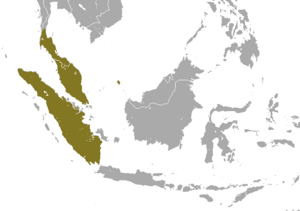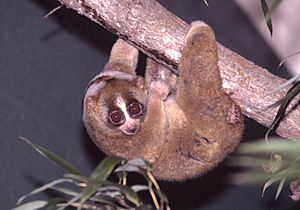Sunda slow loris facts for kids
The Sunda slow loris (Nycticebus coucang), also known as the greater slow loris, is a type of primate found in Indonesia, West Malaysia, southern Thailand, and Singapore. These furry creatures measure about 27 to 38 centimeters (11 to 15 inches) long from head to tail and weigh between 599 and 685 grams (about 1.3 to 1.5 pounds). Like other slow lorises, they have a wet nose, a round head, small ears hidden in their thick fur, a flat face, and large eyes. They also have a very tiny tail that's hard to see.
Sunda slow lorises are active at night (they are nocturnal) and live in trees (they are arboreal). They usually live in evergreen forests, especially rainforests with lots of thick trees. They move very slowly compared to other mammals their size. Their diet includes tree sap, flower nectar, fruits, and insects. They get sap by licking wounds on trees. Sunda slow lorises are mostly solitary, meaning they like to be alone. They usually have one partner for life and their babies stay with them. During the day, they sleep curled up in a ball in hidden spots high up in trees, often on branches or vines. Females usually give birth to one baby after about 192 days. The young loris leaves its parents when it is between 16 and 27 months old, which is usually when it can have its own babies.
Sadly, the Sunda slow loris is an endangered species. This means it is at high risk of disappearing forever. A big threat is the illegal pet trade, where many lorises are sold as pets. Their teeth are often pulled out before they are sold, which can lead to serious infections and even death. Without their teeth, they can't be released back into the wild. They also lose their homes because forests are being cut down.
Quick facts for kids Sunda slow loris |
|
|---|---|
 |
|
| Conservation status | |
| Scientific classification | |
| Genus: |
Nycticebus
|
| Species: |
coucang
|
 |
|
| Sunda slow loris range | |
| Synonyms | |
|
|
Contents
What's in a Name?
The name "Sunda slow loris" comes from the Sunda Islands, where these animals live. Another common name for it is the "greater slow loris." The scientific name, coucang, comes from "kukang," which is its name in Indonesia.
In Indonesia, people also call it malu-malu, meaning "shy," or bukang or Kalamasan. Sometimes, it's called kuskus because locals confuse it with a different animal called a cuscus. In Malaysia, it's known as kongkang or kera duku. Kera means monkey, and duku is a type of fruit tree. In Thailand, it's called ling lom (ลิงลม), which means "wind monkey."
How Scientists Classify the Sunda Slow Loris
Scientists first described the Sunda slow loris in 1785. For a long time, all slow lorises were thought to be one species. But in recent years, scientists have used differences in their looks, like size, fur color, and face markings, to figure out that there are actually many different species of slow lorises.
For example, in 2010, the Sunda slow loris, the Javan slow loris, and the Bornean slow loris were all recognized as separate species. Scientists also use DNA to understand how different loris species are related to each other. This helps them confirm if the way they classify animals based on their looks matches their family tree.
Body and Movement
The Sunda slow loris has dark rings around its big eyes and a white nose with a white stripe going up to its forehead. A dark stripe runs from the back of its head down its spine. Its fur is soft, thick, and woolly, ranging from light brown to reddish-brown, with a lighter belly.
It looks different from the Bengal slow loris because it has dark, tear-shaped markings around its eyes that connect to the dark stripe on its head. The Sunda slow loris also has a clearer white stripe between its eyes and is browner than the Bengal slow loris. It has less white on its face than the smaller pygmy slow loris.
These lorises are about 27 to 38 cm (11 to 15 in) long and weigh 599 to 685 g (1.3 to 1.5 lb). Unlike the Bengal slow loris, males and females of the Sunda slow loris are about the same weight. Their tiny tail is hidden under their fur. They have a special "toothcomb" made of six front teeth on their lower jaw. They use this for grooming and also to scrape off tree gum when they eat. Their second finger is short, and their hands have a very strong grip. Like other lorises, they have glands under their arms that produce a strong-smelling liquid used for communication.
One special thing about all loris species is how they move. The Sunda slow loris moves slowly through trees using all four limbs, usually keeping at least three limbs attached to a branch at all times. Their movement is unique, almost like they are crawling in every direction. They can change direction or move between branches quietly and without changing speed. They can even hang upside down from a branch using just one or both feet for a long time!
Daily Life and Habitat
Like other slow lorises, the Sunda slow loris lives in trees and is active at night. During the day, they rest in tree forks or thick plants. At night, they search for food like fruit and insects. Unlike other loris species, the Sunda slow loris stays in trees most of its life. While the Bengal slow loris might sleep on the ground, the Sunda slow loris sleeps curled up in a ball in branches or leaves. They usually sleep alone, but sometimes they sleep with other lorises, including adults. Adult lorises live in areas that can overlap with others.
Even though they move slowly, Sunda slow lorises eat foods that give them a lot of energy. Their slow lifestyle might be because they need to process certain plant chemicals in their diet. They spend most of their time eating tree sap (about 35%), flower nectar (about 32%), and fruits (about 23%). They also eat tree gums and insects like spiders. They get gum by licking wounds on trees. They have also been known to eat snails and bird eggs.
All slow loris species have a special gland on the inside of their elbows that produces a toxin. They spread this toxin over their bodies and their babies' bodies when they groom themselves using their toothcomb. If a predator threatens them, the Sunda slow loris can bite, roll into a ball to show its toxic fur, or roll up and drop from the trees. However, their main way to avoid predators is to hide and blend in with their surroundings. Snakes like the reticulated python, birds like the changeable hawk-eagle, and Sumatran orangutans are known predators of the Sunda slow loris.
Social Life
The Sunda slow loris is mostly a solitary animal, meaning it prefers to be alone. However, they might live in small groups of one male, one female, and up to three younger lorises where their living areas overlap. When they meet other lorises from different areas, they usually don't react much because they don't defend their territories.
In zoos, however, they can sometimes be aggressive towards each other, with males showing fighting and threatening behaviors. Despite this, they are generally friendly in captivity, and grooming each other is the most common social behavior.
How They Communicate
Sunda slow lorises make eight different types of sounds. These include calls for contact, like whistles, and calls for aggression or defense, like snarls and grunts. Because they hide to avoid predators, they don't make loud alarm calls. Baby lorises make clicks and squeaks when they are bothered. Females make whistle calls when they see a male during mating season. When they explore new places or are handled, they make very high-pitched sounds that humans can't hear.
Smell is very important for communication in these animals. It helps them tell others who they are, how they are feeling, and where they are. It's also important for finding a mate. When a loris finds the scent of another loris, it might rub its face on the spot where the scent was found.
Reproduction and Life Cycle
Reproduction is one of the few times Sunda slow lorises gather together, as they are mostly solitary. Females can start having babies when they are between 18 and 24 months old, and males can start at 17 months. They can mate many times throughout the year.
After about 192 days, the female usually gives birth to one baby, though sometimes twins are born. Both male and female young lorises leave their parents when they are between 16 and 27 months old, usually when they are old enough to have their own babies.
Where They Live
The Sunda slow loris lives in tropical rainforests with continuous tree canopies. They can also adapt to other types of habitats. They are found in Indonesia (on islands like Sumatra, Batam, Galang, Tebing Tinggi Island, and Great Natuna), in Malaysia (on the Malay Peninsula and Pulau Tioman), in the southern part of Thailand, and in Singapore.
Even though it was thought they had disappeared from Pulau Tioman, there are signs that slow lorises might still live there. The lorises on Tioman Island look a bit different from those on the mainland, which suggests they might be a unique group. In Thailand, the Sunda slow loris shares its home with the Bengal slow loris, and sometimes they even have babies together.
Protecting the Sunda Slow Loris
The International Union for Conservation of Nature (IUCN) listed the Sunda slow loris as endangered in 2020. This means it faces a very high risk of extinction. In 2007, international laws were strengthened to forbid trading this species across borders. It is also protected by Indonesian law, but these laws are not always strictly enforced. We don't know exactly how many Sunda slow lorises are left, so more studies are needed to understand their situation better.
The Sunda slow loris is greatly threatened by the illegal pet trade. They are one of the most commonly traded protected primates in Southeast Asia. When sold as pets, their teeth are often pulled out to prevent them from biting their owners. This can cause severe dental infections, which lead to death in up to 90% of cases. Once their teeth are gone, they cannot survive if released back into the wild. Many lorises also die in captivity due to stress, poor food, and infections, which creates a demand for more lorises to be caught and sold.
These animals are also hunted for illegal traditional medicine. People believe their fur can heal wounds, their flesh can cure epilepsy, their eyes are used in love potions, and their meat can help with asthma and stomach problems. They are also sometimes killed by farmers who see them as pests.
A major problem is the loss and damage of their forest homes. This has caused their populations to shrink a lot. When their habitat is broken up into smaller pieces, it's harder for them to move around because they need continuous tree cover to travel from tree to tree.




